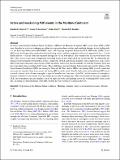Active and weakening MJO events in the Maritime Continent
Author(s)
Barrett, Bradford S.; Densmore, Casey R.; Ray, Pallav; Sanabia, Elizabeth R.
Download382_2021_Article_5699.pdf (4.864Mb)
Publisher with Creative Commons License
Publisher with Creative Commons License
Creative Commons Attribution
Terms of use
Metadata
Show full item recordAbstract
Abstract
To better understand the Madden–Julian Oscillation (MJO) in the Maritime Continent (MC), events from 1980 to 2019 were classified as active or weakening according to propagation characteristics and amplitude changes in two leading indices, the Real-time Multivariate MJO (RMM) index and Outgoing Longwave Radiation (OLR) MJO Index (OMI). Active MJO events had larger index amplitudes than weakening events, and those amplitude differences appeared at day − 3 in the RMM and day − 8 in the OMI and remained through day + 15 in both indices (day 0 marked the day an event entered the MC). Thus, active events were stronger than weakening events as they approached and crossed the MC. To understand differences in environments between these events, composites of OLR and specific humidity were compared for each. Active MJO events had consistently more negative OLR anomalies and greater specific humidity in both the boundary layer and free troposphere than weakening MJO events. Those differences persisted during both easterly and westerly phases of the Quasi-biennial Oscillation (QBO) and during La Niña and El Niño. Active MJO events during QBO westerly winds had more specific humidity than active events did during QBO easterly winds. Finally, both active and weakening MJO events featured a diurnal cycle of lower-tropospheric specific humidity over land areas of the MC, and the amount of atmospheric moisture available to active events was consistently greater than weakening ones. These results indicate that index amplitude, OLR, and tropospheric specific humidity can all be important tools in identifying active and weakening MJO events in the MC, including for different phases of the QBO and the El Niño-Southern Oscillation (ENSO).
Date issued
2021-03-05Department
Woods Hole Oceanographic InstitutionPublisher
Springer Berlin Heidelberg